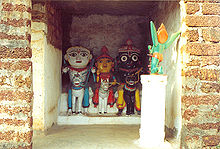Jagannath
Jagannatha (Sanskrit जगन्नाथ Jagannātha; jagat: "world", "universe", natha: "Lord") represents the Hindu god Vishnu. There are different theories about the origins and historical development of the worship of Jagannatha.
Jagannatha enjoys special veneration in the coastal city of Puri in the Indian state of Odisha, where he is worshipped in one of the largest and most important temples of Vishnuism, the Shri Jagannath Temple. Together with his brother Balabhadra and sister Subhadra, he forms a trimurti, a trinity. If Jagannatha is Krishna, who according to Hindu belief once actually lived, Balabhadra represents Krishna's brother Balarama and Subhadra his sister. In Puri today Jagannatha is also equated with Buddha and is depicted there in his place, the place of the ninth avatar of Vishnu.
The Jagannath statue is made of the wood of the Niembaum, which is sacred to Hindus. The head is exceptionally large with oversized eyes, the body, painted with strong colors, is short and only rudimentarily elaborated, without legs and with outstretched arms without hands. A rational reason for this unusual form is not known, but several traditions deal with the background:
Various Puranas, the ancient Hindu books about the gods, report that once Viswavasu, the king of a native people, had originally worshipped Jagannatha as Nilamadhaba in a forest.
![]()
This article or subsequent section is not sufficiently supported by evidence (e.g., anecdotal evidence). Information without sufficient evidence may be removed in the near future. Please help Wikipedia by researching the information and adding good supporting evidence.
The popular oral version is as follows: "The king Indradyumna dreamed that the body of Krishna, after his return to his celestial kingdom, had been washed up on the coast of Puri, together with that of his brother Balarama and his sister Subhadra. A voice commanded him to build a large temple with wooden statues and Krishna's bones should be placed in a depression in the back of the effigy. The dream came true. The king found the bone fragments and gave them to an old carpenter who was none other than Vishwakarma, the divine architect. The latter requested that no one should disturb him while he was working, but when after some months the work was still unfinished, the king impatiently opened the door and on the spot the mysterious old man disappeared. So the king had the unfinished statues ceremoniously installed in the temple and dedicated."
The Trimurti with Jagannatha is pulled once a year during the festival Ratha Yatra, which is known beyond the borders of India and lasts several days, in a procession on three huge god chariots (Ratha) on ropes through the city of Puri. Every year the three Murtis, as Hindus call consecrated statues, are painted anew before the big procession, the striking eyes are drawn by the priests during the service. Every twelve years the murtis are completely exchanged within a rite.
The English language adopted the loanword juggernaut, which derogatorily denotes an "idol" or an "unstoppable idea that rolls everything down", since believers supposedly threw themselves in fanatical religious frenzy before the wheels of the "juggernaut" in order to sacrifice themselves to their god.

Jagannatha (black) with his siblings Balabhadra (white) and Shubhadra (yellow) in a village temple in Odisha. In the foreground in worship pose Garuda, the companion bird of Vishnu.
Search within the encyclopedia